In the jurisdiction of contemporary painting, where the tension between restraint and excess forms an important creative threshold, the exhibitio
In the jurisdiction of contemporary painting, where the tension between restraint and excess forms an important creative threshold, the exhibition “Dreamers” comes out as a fascinating case study. Featuring five painters, Asif Hussain, Qindeel Usman, Akash Jivraj, Muhammad Asif and Zeenat Khan, whose works steer the ground between intricate ornamentation and almost overwhelming density, Dreamers look at the fine balance between visual opulence and conceptual depth. The curator, Aasim Akhtar, suggests that these artists engage with an eclectic visual language that spans art history, personal narrative, and cultural memory, positioning their practice within an expanded aesthetic discourse. However, while the exhibition achieves moments of brilliance in its articulation of painterly ‘auto-fiction’ – a term suggesting a blend of personal storytelling and artistic invention, one must also consider the cultural and regional frameworks that inform this kind of visual complexity. In particular, a South Asian perspective complicates and deepens the exhibition’s underlying themes, revealing more profound meanings between its visual strategy and the aesthetic traditions of the subcontinent.
The exhibition’s emphasis on “fabulous intricacy” and “overabundance” offers a productive comparison with South Asian artistic traditions. Historically, miniature painting, truck art, and textile design have thrived on maximalist visual languages that favor intricate detailing and layered compositions. Unlike the Western modernist preoccupation with minimalism, South Asian visual culture has long embraced a philosophy of abundance, where excess does not signify indulgence but rather an immersive, almost meditative state of perception. In Dreamers, the artists’ approach to painting—rich surfaces, decorative intensity, and visual density—finds an inadvertent kinship with these traditions. Yet, rather than merely reproducing historical modes, they adapt these techniques to reflect contemporary concerns, making their art both deeply referential and refreshingly new.
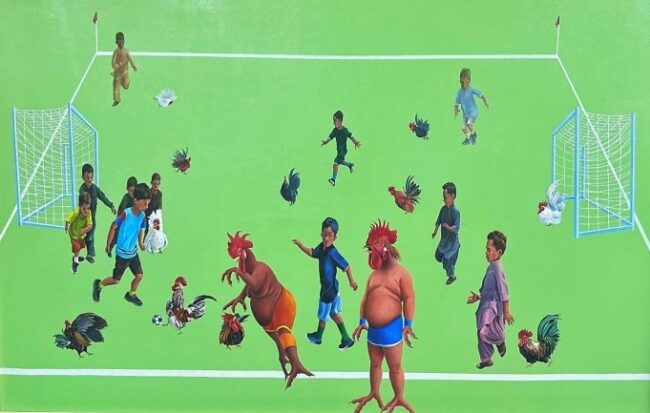
Muhammad Asif
The exhibition’s belief in painterly auto-fiction introduces an interesting way to think about contemporary portraiture. The idea that painting can fictionalize and manipulate autobiographical elements speaks more broadly about identity; one that is fluid, hybridized, and negotiated through various cultural, historical, and personal references. In South Asia, where colonial legacies and postcolonial identities remain central to artistic discourse, the representation of the self is always fraught with historical baggage. Artists in the region have often grappled with the politics of visibility, negotiating between inherited artistic traditions and global contemporary practices. The painters in Dreamers appear to traverse similar ground, using a diverse range of styles and techniques to question how identities are formed, fractured, and projected onto the canvas.
One of the more prominent curatorial claims is that the artists in Dreamers seek to “fluster the distinctions between people and things, between the body and its surroundings.” This chemistry between the figure and its spatial environment suggests a larger discourse on the body’s materiality – both as a physical form and a metaphorical construct. In South Asia, where gender, class, and postcolonial realities shape bodily representation, such an approach takes on particular firmness. The historical tradition of Mughal portraiture, for instance, often framed the figure as a site of both political power and aesthetic pleasure. At the same time, contemporary South Asian artists have reinterpreted these conventions to critique gendered and socio-political constraints. In Dreamers, how the human form merges with or stands apart from its environment may be read as an extension of this historical conversation.
Aasim Akhtar highlights the exhibition’s focus on “pleasurable formal elements and spectacular craftsmanship,” signifying that technical mastery is central to these works. Indeed, the visual spectacle in Dreamers is undeniable, with compositions that astonish and command attention. However, beyond their immediate sensory appeal, these paintings engage with more complex discourses; particularly those surrounding gender.

Asif Hussain’s exploration of longing and isolation through the Chakoor bird and a solitary male figure presents a lyrical reflection on unattainable desires. His use of stark landscapes enhances the thematic depth of emotional emptiness, creating a compelling interplay between realism and symbolism.
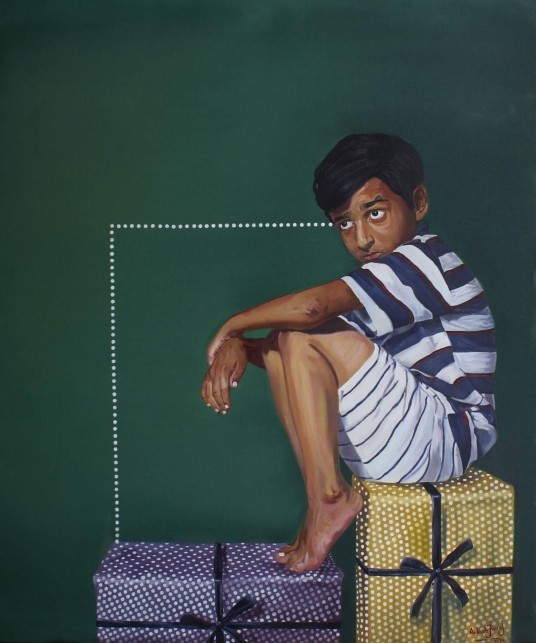
Akash Jivraj
Akash Jivraj’s engagement with the concept of gifts as ideological markers is conceptually rich, illustrating connections between material exchange and the transformation of values over time. The metaphor of gift wrapping as both concealment and revelation is particularly interesting.
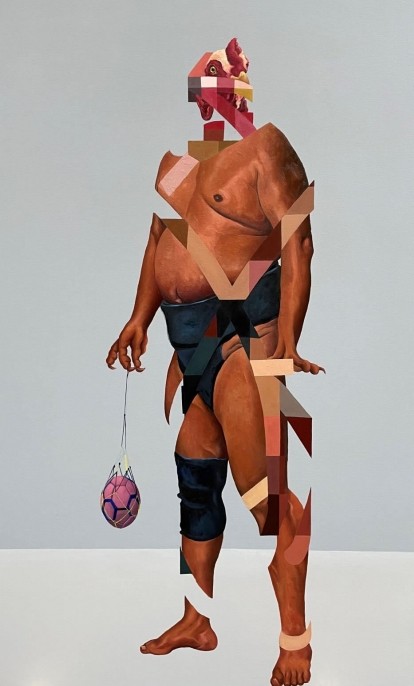
Muhammad Asif
Muhammad Asif’s whimsical portrayal of roosters in human-like scenarios injects humor and playfulness into an otherwise overlooked subject. His vibrant compositions celebrate joy and challenge conventional notions of farm animals as passive beings.
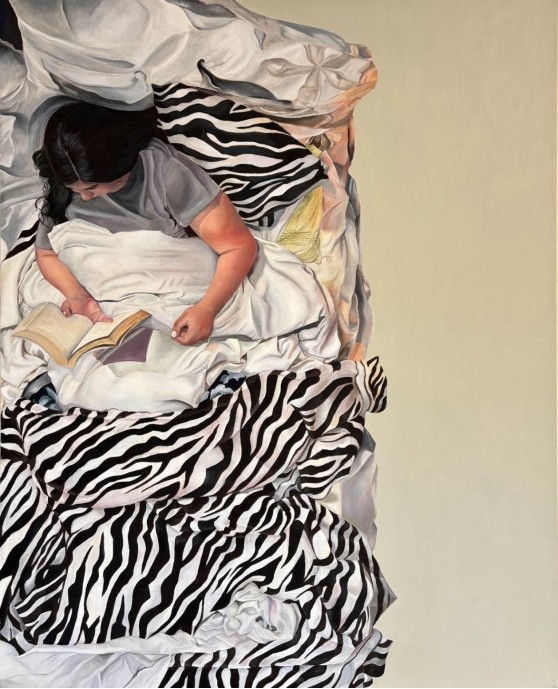
Qindeel Usman
Qindeel Usman’s atmospheric use of drapery as a metaphor for intimacy and solace is visually evocative. The soft, flowing forms invite contemplation, creating a quiet yet powerful presence on the canvas. Whereas Zeenat Khan’s focus on transparency as an artistic and philosophical stance offers an intriguing counterpoint to societal obsessions with perfection. Her exploration of inner dialogues and the pursuit of authenticity resonates within contemporary discourses on identity.
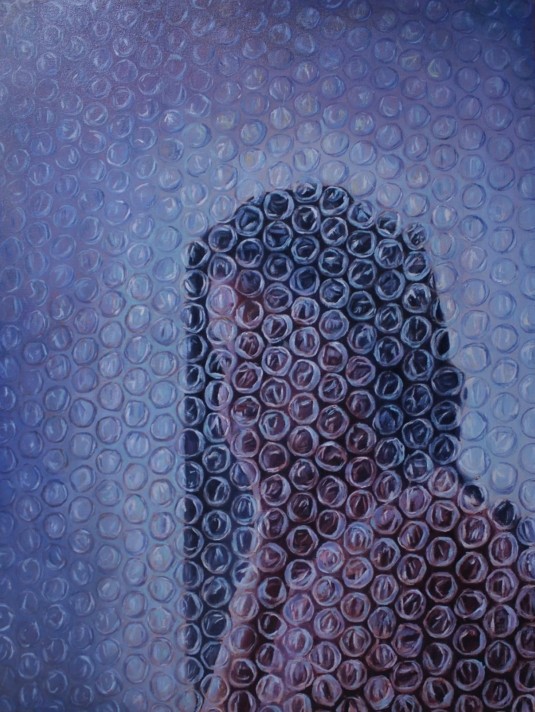
Zeenat Khan
Dreamers succeed in presenting an opulently textured exploration of contemporary painting, one that is at once deeply personal and expansively referential. Its engagement with art history, self-representation, and the materiality of the body makes it a captivating exhibition that resounds beyond its immediate cultural setting. However, from a South Asian perspective, its visual strategies and thematic concerns gain additional depth, aligning with long-standing aesthetic traditions while pushing them into new conceptual territories. In this sense, the exhibition does not merely revisit the question of when a painting is finished, rather it reimagines painting itself as a dynamic, evolving conversation between past and present, between self and society, between excess and restraint. And in that unresolved tension, Dreamers finds its most powerful artistic force.
